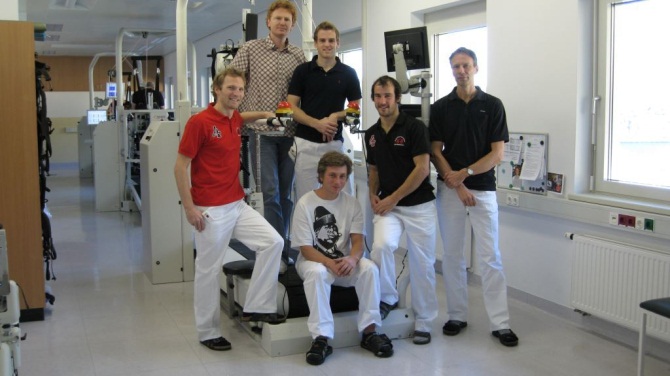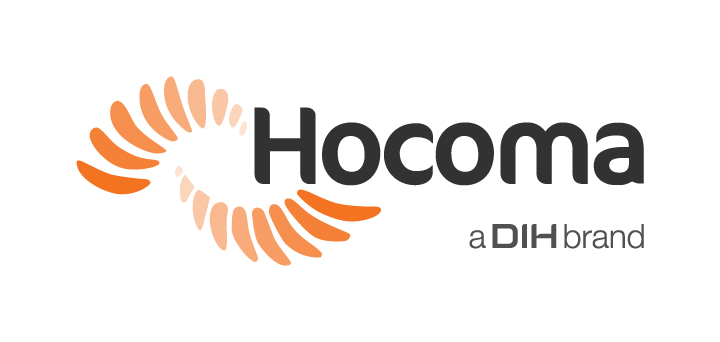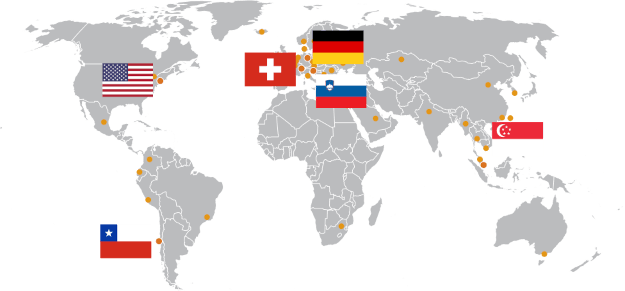January 12, 2015
Clinical Integration of the Erigo®: Hospital Hochzirl

Neurology department team members, Hospital Hochzirl, Austria.
Martin Niedermeier, Sport Scientist
Hospital Hochzirl, Austria
After several years working with the Erigo, we have a well-defined setting of how the device is integrated within the rehabilitation of the patient. This clinical setting is based on our own experience and is influenced by our infrastructure, patient population, health system and clinic organization, among other factors. Hospital Hochzirl is very experienced in applying robotic-assisted therapy to acute and chronic neurological patients. Thanks to our unique therapy setting in the robotics department, which has several devices in parallel, we are able to work with high efficiency.
Here we describe our clinical setting and hope that it serves as an example to support other clinics that also work with the Erigo.
Patient Group
We use the Erigo with acute patients in the early phase of rehabilitation as well as chronic, severely affected patients.
The patient has to fit the device specific indications and be free from contraindications. Moreover, there is no special assessment for early functional training in our hospital. The responsible physical therapists make proposals about which patients should receive Erigo treatment. The medical director reviews the proposals and makes the final decision
Duration and Frequency of Erigo® Sessions
Patients receive Erigo treatment 2-5 times per week depending on the therapy goal and the capacity of the robotics department.
In rare cases, we treat patients in the morning and in the afternoon resulting in 10 sessions per week. Erigo treatment is given on an hourly basis which allows for stepping time to range between 45 and 50 minutes.
The total duration of Erigo treatment depends on the therapy goals, the progress of the patients and the seriousness of the injury or event.
The goal of the treatment for chronic patients is to reduce all the physical problems associated with inactivity. To support with this, they receive Erigo treatment during the entire hospitalization period. This time ranges between 3 to 15 months.
For acute patients, the goal of rehabilitation is often to regain the ability to walk. Therefore, they receive Erigo treatment until they reach a cardiovascular stability that allows the patient to walk upright transfer to the Lokomat. The training period ranges between one week to two months.
Reasons to Include the Erigo® as Part of the Therapy Program
We use the Erigo as a tool for treating the above-mentioned patient groups because patients can be mobilized at an early stage of rehabilitation to counteract the known effects of immobility.
The Erigo offers easy intensity regulation with adjustable step cadence, tilt angle and leg loading. This guarantees delivery of individual and appropriate inputs to patients who are deprived of their senses and without access to their surroundings.
Activity is the basis of motor improvement, and Erigo treatment positively supports with activity. This positively influenced activity makes the Erigo an appropriate tool to start rehabilitation in early phases.
Erigo treatment can easily be performed by one clinician (sometimes two clinicians are necessary for the transfer). Therefore, in our experience from clinical practice Erigo treatment is efficient and less burdensome on the clinicians.
Other Therapies Provided in Addition to Robotic Rehabilitation
- Physical therapy (Bobath)
- Ergotherapy (Bobath)
- Electrical stimulation
- Robotics in general (Lokomat, Armeo, Amadeo, Hirob)
- Mc Millan (water therapy)
- Speech therapy
- Anti-spastic drug treatment

Patient treated on the Erigo® at Hospital Hochzirl, Austria.
Organization: Responsible Therapy Team
At our clinic, Erigo and Lokomat treatment is carried out by one physical therapist and a team of four sport scientists. Robotic therapy is delivered to four patients simultaneously with only two therapists.
Before the patient starts treatment, the sport scientists discuss with the physical therapist in charge the therapy goals and the possible inclusion of robotic therapy.
Our experience with our Erigo specialists showed several advantages, since they have an experienced eye to properly set all the parameters and routine makes them faster for all the process.
In many cases, relatives of the patients come to Erigo sessions at our hospital. We know that this is not common in other hospitals, but we feel having a relative with the patient offers several advantages. Because family members spend much more time with the patient, they therefore understand the patient’s signs better. Sometimes they even have a special communication system, they often know special things to take care of and they often have a calming influence on the patient.
As mentioned, two therapists work on four devices simultaneously. After they have put the patient into the device (Erigo, Lokomat), they make individual adjustments and give instructions regarding the therapy goals. When everything is set and the patient is feeling secure, robotic training starts and the clinicians move on to the next patient. During the session, the clinicians give further instructions or corrections. In case of danger or required assistance, one clinician takes care of the patient immediately.
There is the disadvantage that the clinician cannot observe the entire treatment session, but the patient is alone only when the presence of the clinician is not critical. Moreover, this system allows the clinicians to treat twice as many patients per day than by doing one-to-one therapy.
Billing and Financial Compensation of Erigo® Therapy
There is no special refunding for our robotic treatment in general. Robotics, especially Erigo, is a part of the rehabilitation process at our hospital, which is covered by the health insurance.
In other occasions our medical director visits private patients who pay the therapy on their own. Private patients pay a doctor’s fee and for the treatment time they receive. The charge is the same for Erigo treatment as for other types of therapy.
About us
The Department of Neurology at Hospital Hochzirl in Austria is a 74-bed unit for post-acute follow-up assistance for neurorehabilitation. The department was established in 1995 and patients with various neurological injuries or diseases are attended. Besides conventional physical therapy, the department provides ergo therapy, speech therapy, electrical stimulation and water therapy. We have been providing robotic-assisted training since 2002; specifically, Lokomat, Erigo, Armeo, Amadeo and Hirob are used to rehabilitate our patients. Our robotics team consists of one physical therapist and four sport scientists.
This clinical experience report is meant to serve as an example of how the Erigo® is integrated into the clinical setting in one individual hospital. It is not necessarily a standard recommendation from Hocoma.


